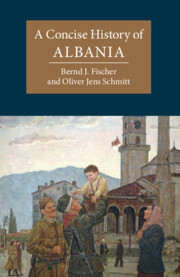Book contents
- A Concise History of Albania
- Cambridge Concise Histories
- A Concise History of Albania
- Copyright page
- Contents
- Illustrations
- Maps
- Preface
- Part I Between Regional Self-Will and Imperial Rule
- 1 The Space and Time of Albanian History
- 2 The Albanians in the Middle Ages, 500–1500
- 3 The Albanians under Ottoman Rule: The Classic Period of Arnavutluk, 1500–1800
- 4 Ottoman Arnavutluk in Crisis, 1800–1912
- Part II State and Nation Construction
- Political Systems and the Principal Political Leadership since Independence in 1912
- Suggestions for Further Reading (literature in non-Balkan languages)
- Index
2 - The Albanians in the Middle Ages, 500–1500
from Part I - Between Regional Self-Will and Imperial Rule
Published online by Cambridge University Press: 18 October 2022
- A Concise History of Albania
- Cambridge Concise Histories
- A Concise History of Albania
- Copyright page
- Contents
- Illustrations
- Maps
- Preface
- Part I Between Regional Self-Will and Imperial Rule
- 1 The Space and Time of Albanian History
- 2 The Albanians in the Middle Ages, 500–1500
- 3 The Albanians under Ottoman Rule: The Classic Period of Arnavutluk, 1500–1800
- 4 Ottoman Arnavutluk in Crisis, 1800–1912
- Part II State and Nation Construction
- Political Systems and the Principal Political Leadership since Independence in 1912
- Suggestions for Further Reading (literature in non-Balkan languages)
- Index
Summary
Chapter 2 traces Albanian history through the Roman and Byzantine periods. The ancestors of contemporary Albanians were well integrated into these empires. The Latin influence on the Albanian language is correspondingly strong. In late antiquity, the Roman empire recruited an important part of its elite from the southwestern Balkans. The arrival of Slavic groups in the Balkans led to the collapse of state administration and the church and thus to a cultural turning point that was much more profound than in Western Europe. It was not until the ninth century that Byzantium was primarily re-Christianized. The Albanians came under the influence of the new Slavic states in the Balkans. Urban communities flourished particularly along the coast. The region was closely intertwined with the Venetian-Adriatic culture, but also with Byzantine civilization. With the decline of Byzantium, the southwestern Balkan region splintered into numerous small dominions. Venice, the Kingdom of Naples and, from the end of the fourteenth century, the Ottomans vied for influence. Albania was one of the first areas in the Balkans conquered by the Ottomans and nowhere was the resistance to the new empire as fierce as in Albania. Georg Kastriota Scanderbeg, who is revered as a national hero today, is symbolic of this resistence.
Keywords
- Type
- Chapter
- Information
- A Concise History of Albania , pp. 23 - 56Publisher: Cambridge University PressPrint publication year: 2022



